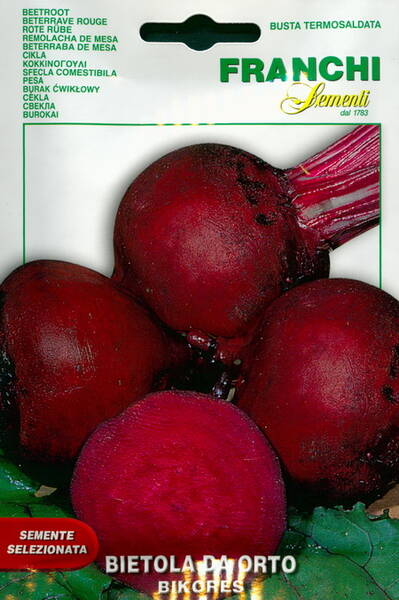Late fertile cultivar from Holland (Bejo Zaden): grows within 120-125 days after seeding. Strong foliage. Root crops are round, dark red. Suitable storage, processing and making natural dyes.
High-yielding beet variety for storage, processing and fresh consumption. Root crops are rounded, uniform in size, the flesh is of a uniform dark burgundy color without radial rings, the skin is smooth.
AGROTECHNICS.
Beets grow best in rich, fertile soils with a neutral reaction. In heavy soils, it must be grown in ridges.
The best predecessors are early potatoes, cucumber, onions, pumpkin, zucchini. In the fall, humus is applied to the site for beets, if necessary, the soil is limed, in the spring, a complex mineral fertilizer is applied. Seeds are sown in late April - early May to a depth of 2-4 cm in rows with row spacing of 25-30 cm and a distance between seeds of 8-10 cm. Thinning is not required. Further care consists in loosening, regular feeding and watering. Beet seeds can be sown before winter in late October - early November.
* BORSCH is the main first dish of Ukrainian cuisine, which has received the widest international distribution.
In borscht, not only pork is used, but also beef, lamb, ham, sausages, chicken, duck, goose, or only bone broth (without meat).
Its vegetable part is even more diverse: potatoes, cabbage, zucchini, beans, tomatoes, apples, turnips, carrots, pea pods, bell peppers and corn.
But no matter how many and what kind of vegetables are used in this or that kind of borscht, the main and main component that determines its taste is beets.
Moreover, it can be fresh, pickled, in the form of brine or tops, but it always dominates in any borscht!
An important distinguishing feature is also the abundant use of spicy plants: without onions (bulb and green), garlic, pepper (red and black), lovage, angelica, dill, marjoram, savory, parsley, celery, there can be no good, real borscht.
Borscht has many regional varieties.
For example, dough products are poured into some types of borscht: dumplings are added to Poltava borscht, small dumplings are added to Lithuanian borscht, "ears" (small pieces of dough) or noodles are added to Odessa borscht, flour podboltka is added to Chernigov borscht.
The liquid part of borscht only partially consists of water (it is used to boil meat or bones), and mainly from special liquids: kvass-surovets, beetroot kvass, beetroot brine, or, in extreme cases, ordinary bread kvass.
The choice of this or that liquid depends on the composition of the borscht, is associated with its name and, of course, has an impact on the overall taste.
That is why "Lvov" borsch is not similar to "Odessa", and "Poltava" - to "Volyn", "Chernigov" - to "Kyiv", "Transcarpathian" - to "Kharkiv", etc.
Mushrooms, mustard are added to some types of borscht...
But common to them, like beets, is such a dressing as sour cream - it is part of almost all borscht, except for "Odessa" and "Lithuanian", cooked on chicken and goose broths.
Thus, in terms of its composition and set of products, borscht is a complex dish that combines about 20 or more components.
Based on the cooking technology, it belongs to the category of dressing soups (some of the products of which are first sautéed in a pan, and only then put into the broth).
It takes at least 2-3 hours to cook borscht.
Ukrainian borscht is usually served with wheat donuts or donuts with onions. It is with them, and not with rye bread, that the taste of real Ukrainian borscht is appreciated.












